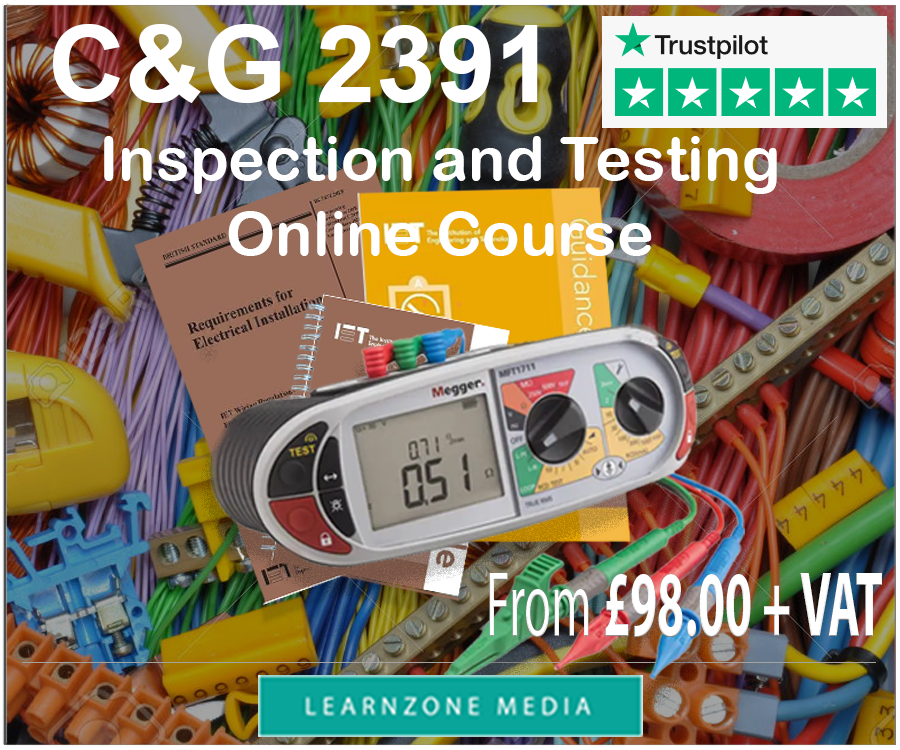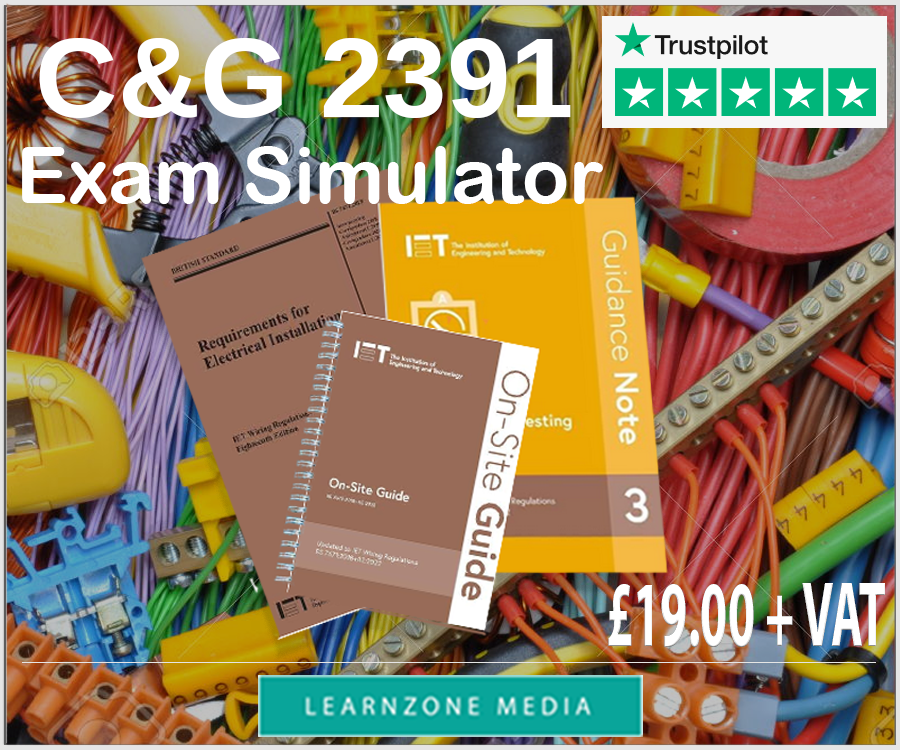C&G 2391 Unit 301 - Sample Test No:1
Unit 301 multiple choice examination covers areas of knowladge and understanding which are common to both initial verification and periodic inspection. This assessment is the same assessment for both qualifications and learners need only achieve the test once.
The sample test below has 40 questions, the same number as the online exam. The allowed time for the exam is 1 hour and 20 minutes. You will find the answers on the last page.
1. On completion of a new installation, the Electrical Installation Certificate would 'not' be signed by the::
a) Design engineer
b) Client
c) Person who constructed the installation
d) Inspection and testing engineer
2. Before inspecting the condition of electrical equipment installed in a new unoccupied building, the inspector should:
a) Ask the builders if they are aware of any faults
b) Disconnect all fluorescent luminaires
c) Test run the equipment to ascertain its condition
d) check for components that may be susceptible to damage during testing
3. BS 7671 states that no additions or alterations should be made to an existing installation unless:
a) the completion certificate can be produced for the existing installation
b) a Minor Works Certificate can be produced
c) the permission of the supply company has been obtained
d) the existing installation conforms to current Regulations.
4. On completion of a new installation, the interval before the first periodic inspection would be decided by the:
a) installer.
b) installation designer.
c) client.
d) inspection and testing engineer.
5. Any addition to an existing installation should:
a) have a similar wiring system to that used in the existing installation
b) be inspected and tested separate from the existing installation
c) not impair the safety of the existing installation
d) have its own energy meter separate from that of the existing installation
6. Which of the following duties is ‘not’ the responsibility of the inspector:
a) to carry out maintenance and repairs on the installation
b) to compare the test results with the design criteria
c) to advise on remedial works
d) to recommend the immediate isolation of defective parts
7. In order to undertake the inspection and testing of an electrical installation a person must be a:
a) Competent person
b) Principle person
c) Duty person
d) Registered person
8. The term Dutyholder" used in the Electricity At Work Regulations refers to the person:
a) Making the final payment on completion of the work
b) Responsible for electrical installation
c) Reviewing the documents
d) Ordering the work
9. Which of the following identifies the correct process for safe isolation of a circuit protected by a circuit breaker?
a) Switch off, post notices
b) Switch off, lock off, post notices
c) Switch off, lock off, confirm isolation
d) Switch off, lock off, confirm isolation, post notices
10. Inspection of a fully enclosed domestic consumer unit would not need verification for:
a) identification of conductors
b) rating and type of protective devices
c) IP rating
d) correct connection of single-pole devices
11. When inspecting for adequate 'basic protection' (protection against electric shock or direct contact) which of the following does not require inspection. Presence and condition of:
a) insulation
b) enclosures
c) barriers
d) cpc's
12. The measured value of loop impedance for a circuit is 2.4Ω. If the temperature at the time of the test was 20°C and the cable is 70°C (factor 1.2) what is the corrected value. Ze = 0.4Ω:
a) 2.88 Ω
b) 2.8 Ω
c) 2.4 Ω
d) 2.0 Ω
13. Put the following tests in the correct sequence: 1- earth fault loop impedance 2- polarity 3- ring circuit continuity 4- prospective fault current:
a) 1.3.2.4
b) 2.4.1.3
c) 1.4.3.2.
d) 4.1.2.3.
14. On a new installation, which one of the following should be made available to the person conducting the inspection and test:
a) Details of the customer
b) Schedule of test results
c) Relevant charts, tables and diagrams.
d) Previous test results
15. The statutory document that specifically identifies an installer must be competent to confirm the electrical work they undertake is safe is the :
a) Electricity Safety, Quality and Continuity Regulations
b) Electricity at Work Regulations
c) Health and Safety at Work Act.
d) BS 7671: 2008
16. The safest method of making sure an installation is safe to work on would be:
a) To check the installation with a fluke tester
b) To ensure that RCDs are functional
c) To isolate the installation at the main cut-out
d) To follow a safe isolation procedure.
17. Defects or omissions revealed during initial verification shall:
a) be made good before the certificate is issued
b) be made good after the certificate is issued
c) be made good within 30 days of the certificate being issued
d) be made good when the certificate is issued.
18. Work is to be carried out on an installation which includes a Solar PV supply system. Which of the following must be carried out before isolating the DNO`s supply to the installation?
a) Isolate the Solar PV supply
b) Disconnect the installation loads
c) Close all the switches
d) Disconnect the bonding conductors
19. A test of earth fault loop impedance is to be carried out in an area which is accessible to the public. Which of the following is not a suitable method of protecting the public from the risk of electric shock?
a) Barriers
b) Warning signs
c) Safe isolation
d) Restricting access
20. Work is to be carried out at the distribution board supplying a multi-storey office building. Which of the following must be placed out of service, to ensure the safety of the users, before the safe isolation of the distribution board is carried out?
a) General lighting circuits
b) Air conditioning system
c) Lifts to all floors
d) Burglar alarms





